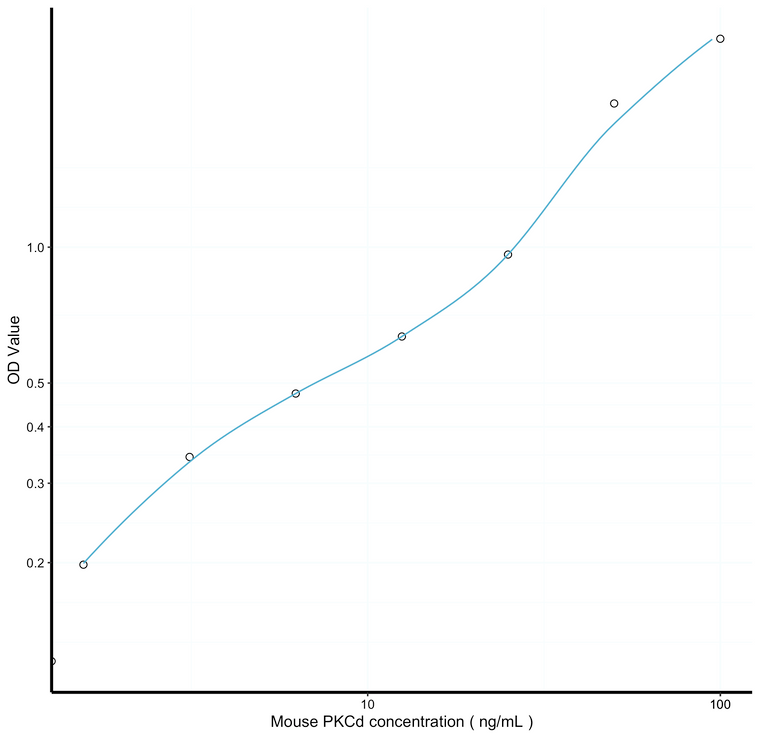| Applications: |
ELISA |
| Reactivity: |
Mouse |
| Note: |
STRICTLY FOR FURTHER SCIENTIFIC RESEARCH USE ONLY (RUO). MUST NOT TO BE USED IN DIAGNOSTIC OR THERAPEUTIC APPLICATIONS. |
| Sensitivity: |
0.54ng/mL |
| Detection Limit: |
1.56-100ng/mL |
| Short Description: |
This PKCd Sandwich ELISA Kit, Ready-To-Use is an in-vitro enzyme-linked immunosorbent assay for the measurement of samples in mouse cell culture supernatant, serum and plasma (EDTA, citrate, heparin). |
| Storage Instruction: |
The whole kit may be stored at-20°C for up to 12 months from receipt. An unopened kit may be stored in the fridge at 2-8°C for up to 6 months. Once opened store individual kit contents according to components table provided with the kit. |
| Assay Time: |
3 hrs |
| Gene Symbol: |
Prkcd |
| Gene ID: |
18753 |
| Uniprot ID: |
KPCD_MOUSE |
| Immunogen Region: |
Ready-To-Use |
| Sample Type: |
serum, plasma, tissue homogenates or other biological fluids. |
| Tissue Specificity | Isoform 1 is highly expressed in developing pro- and pre-B-cells and moderately in mature T-cells. Isoform 2 is highly expressed in testis and ovary and at a lower level in thymocytes, brain and kidney. |
| Post Translational Modifications | Autophosphorylated and/or phosphorylated at Thr-505, within the activation loop.phosphorylation at Thr-505 is not a prerequisite for enzymatic activity. Autophosphorylated at Ser-299. Upon TNFSF10/TRAIL treatment, phosphorylated at Tyr-155.phosphorylation is required for its translocation to the endoplasmic reticulum and cleavage by caspase-3. Phosphorylated at Tyr-311, Tyr-332 and Tyr-565.phosphorylation of Tyr-311 and Tyr-565 following thrombin or zymosan stimulation potentiates its kinase activity. Phosphorylated by protein kinase PDPK1.phosphorylation is inhibited by the apoptotic C-terminal cleavage product of PKN2. Phosphorylated at Tyr-311 through a SYK and SRC mechanism downstream of C-type lectin receptors activation, promoting its activation. Proteolytically cleaved into a catalytic subunit and a regulatory subunit by caspase-3 during apoptosis which results in kinase activation. |
| Function | Calcium-independent, phospholipid- and diacylglycerol (DAG)-dependent serine/threonine-protein kinase that plays contrasting roles in cell death and cell survival by functioning as a pro-apoptotic protein during DNA damage-induced apoptosis, but acting as an anti-apoptotic protein during cytokine receptor-initiated cell death, is involved in tumor suppression, is required for oxygen radical production by NADPH oxidase and acts as positive or negative regulator in platelet functional responses. Negatively regulates B cell proliferation and also has an important function in self-antigen induced B cell tolerance induction. Upon DNA damage, activates the promoter of the death-promoting transcription factor BCLAF1/Btf to trigger BCLAF1-mediated p53/TP53 gene transcription and apoptosis. In response to oxidative stress, interact with and activate CHUK/IKKA in the nucleus, causing the phosphorylation of p53/TP53. In the case of ER stress or DNA damage-induced apoptosis, can form a complex with the tyrosine-protein kinase ABL1 which trigger apoptosis independently of p53/TP53. In cytosol can trigger apoptosis by activating MAPK11 or MAPK14, inhibiting AKT1 and decreasing the level of X-linked inhibitor of apoptosis protein (XIAP), whereas in nucleus induces apoptosis via the activation of MAPK8 or MAPK9. Upon ionizing radiation treatment, is required for the activation of the apoptosis regulators BAX and BAK, which trigger the mitochondrial cell death pathway. Can phosphorylate MCL1 and target it for degradation which is sufficient to trigger for BAX activation and apoptosis. Is required for the control of cell cycle progression both at G1/S and G2/M phases. Mediates phorbol 12-myristate 13-acetate (PMA)-induced inhibition of cell cycle progression at G1/S phase by up-regulating the CDK inhibitor CDKN1A/p21 and inhibiting the cyclin CCNA2 promoter activity. In response to UV irradiation can phosphorylate CDK1, which is important for the G2/M DNA damage checkpoint activation. Can protect glioma cells from the apoptosis induced by TNFSF10/TRAIL, probably by inducing increased phosphorylation and subsequent activation of AKT1. Can also act as tumor suppressor upon mitogenic stimulation with PMA or TPA. In N-formyl-methionyl-leucyl-phenylalanine (fMLP)-treated cells, is required for NCF1 (p47-phox) phosphorylation and activation of NADPH oxidase activity, and regulates TNF-elicited superoxide anion production in neutrophils, by direct phosphorylation and activation of NCF1 or indirectly through MAPK1/3 (ERK1/2) signaling pathways. Involved in antifungal immunity by mediating phosphorylation and activation of CARD9 downstream of C-type lectin receptors activation, promoting interaction between CARD9 and BCL10, followed by activation of NF-kappa-B and MAP kinase p38 pathways. May also play a role in the regulation of NADPH oxidase activity in eosinophil after stimulation with IL5, leukotriene B4 or PMA. In collagen-induced platelet aggregation, acts a negative regulator of filopodia formation and actin polymerization by interacting with and negatively regulating VASP phosphorylation. Downstream of PAR1, PAR4 and CD36/GP4 receptors, regulates differentially platelet dense granule secretion.acts as a positive regulator in PAR-mediated granule secretion, whereas it negatively regulates CD36/GP4-mediated granule release. Phosphorylates MUC1 in the C-terminal and regulates the interaction between MUC1 and beta-catenin. The catalytic subunit phosphorylates 14-3-3 proteins (YWHAB, YWHAZ and YWHAH) in a sphingosine-dependent fashion. Phosphorylates ELAVL1 in response to angiotensin-2 treatment. Phosphorylates mitochondrial phospholipid scramblase 3 (PLSCR3), resulting in increased cardiolipin expression on the mitochondrial outer membrane which facilitates apoptosis. Phosphorylates SMPD1 which induces SMPD1 secretion. |
| Protein Name | Protein Kinase C Delta TypeTyrosine-Protein Kinase PrkcdNpkc-Delta Cleaved Into - Protein Kinase C Delta Type Regulatory Subunit - Protein Kinase C Delta Type Catalytic SubunitSphingosine-Dependent Protein Kinase-1Sdk1 |
| Database Links | Reactome: R-MMU-111465Reactome: -MMU-111933Reactome: -MMU-114508Reactome: -MMU-1250196Reactome: -MMU-1489509Reactome: -MMU-2029485Reactome: -MMU-450520Reactome: -MMU-5218921Reactome: -MMU-5607764Reactome: -MMU-5668599Reactome: -MMU-6798695Reactome: -MMU-877300 |
| Cellular Localisation | CytoplasmPerinuclear RegionNucleusCell MembranePeripheral Membrane ProteinMitochondrionEndomembrane SystemTranslocates To The Mitochondria Upon Apoptotic StimulationUpon ActivationTranslocates To The Plasma Membrane Followed By Partial Location To The Endolysosomes |
| Alternative ELISA Names | Protein Kinase C Delta Type ELISA kitTyrosine-Protein Kinase Prkcd ELISA kitNpkc-Delta Cleaved Into - Protein Kinase C Delta Type Regulatory Subunit - Protein Kinase C Delta Type Catalytic Subunit ELISA kitSphingosine-Dependent Protein Kinase-1 ELISA kitSdk1 ELISA kitPrkcd ELISA kitPkcd ELISA kit |
| output | |
Information sourced from Uniprot.org
12 months for antibodies. 6 months for ELISA Kits. Please see website T&Cs for further guidance







